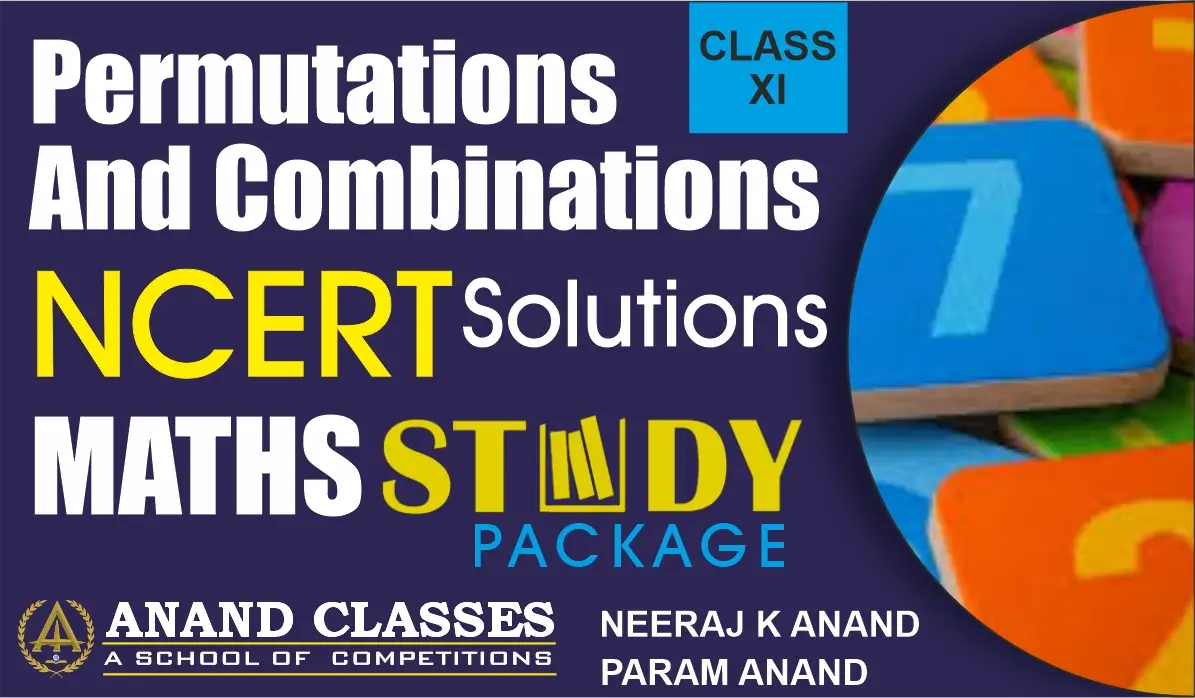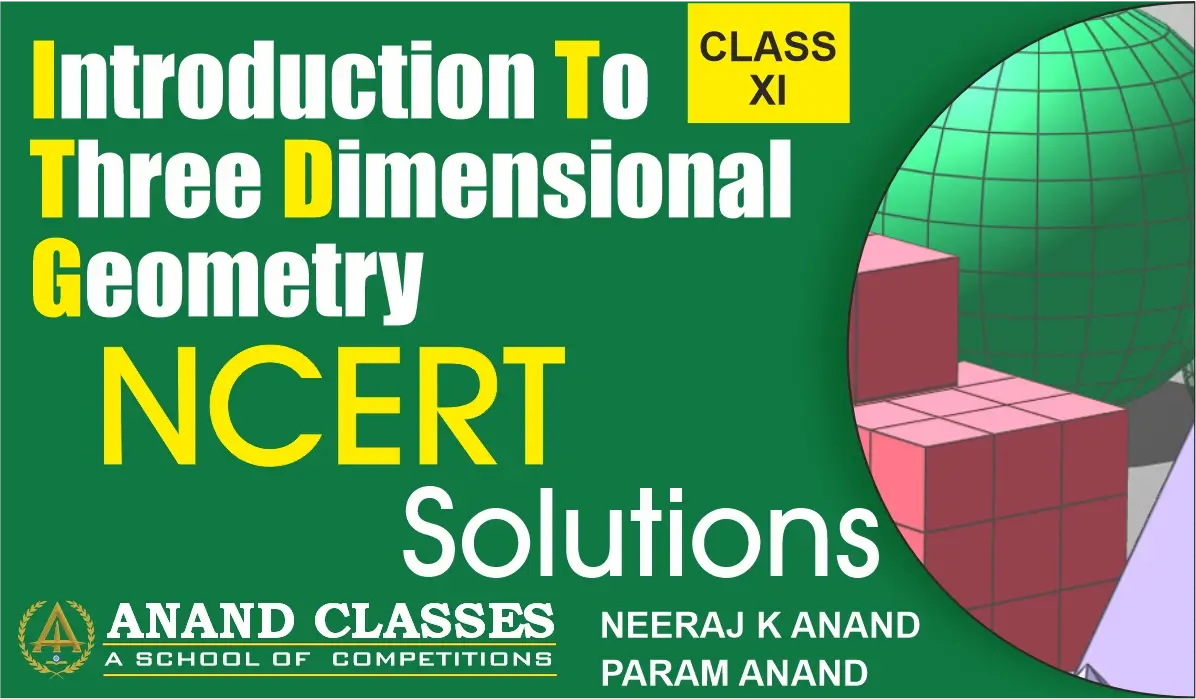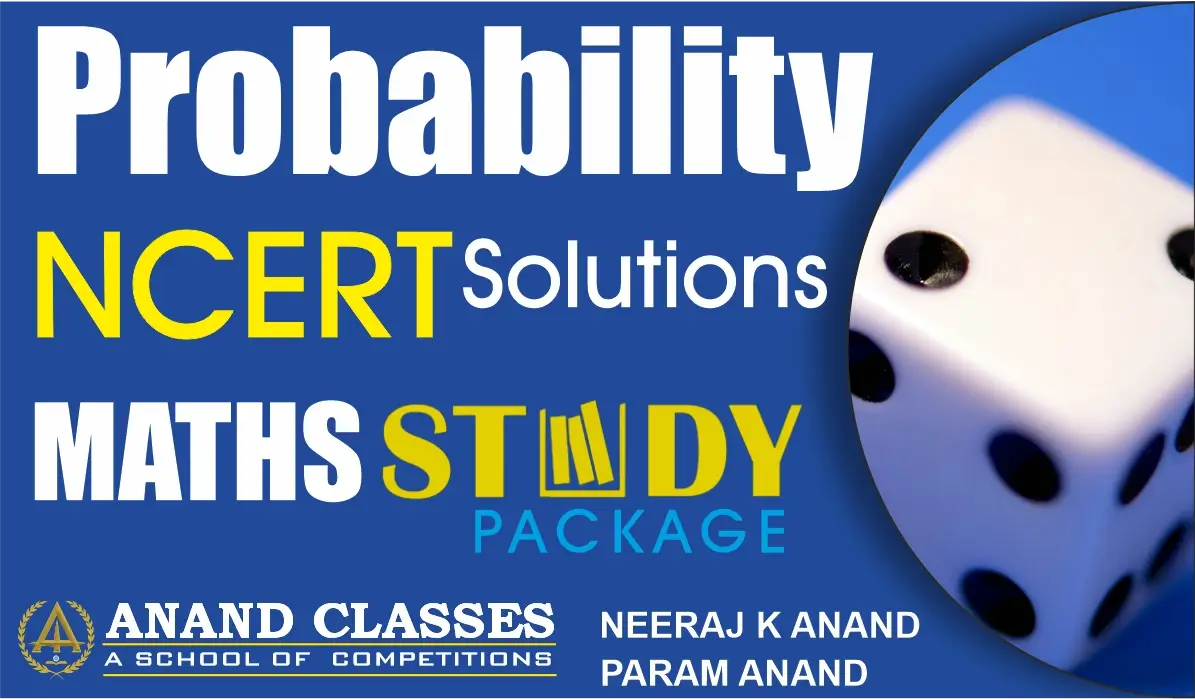Anand Classes offers detailed NCERT Solutions for Class 11 Maths Chapter 6 Permutations and Combinations Exercise 6.4, created to help students understand complex concepts of combination and arrangement in real-life mathematical problems. These step-by-step solutions strictly follow the latest CBSE and NCERT syllabus, ensuring conceptual clarity and exam-oriented preparation. Each solution includes proper reasoning, formulas, and solved examples to make learning easy and effective. Click the print button to download study material and notes.
NCERT Question.1 : If ${}^{n}C_{8} = {}^{n}C_{2}$ find ${}^{n}C_{2}$.
Solution :
We use the identity ${}^{n}C_{p}={}^{n}C_{q}\Rightarrow p=q$ or $p+q=n$.
Since $8\neq 2$, we must have $8+2=n$, so $n=10$.
Thus
$$
{}^{n}C_{2} = {}^{10}C_{2}=\frac{10\times9}{2}=45.
$$
NCERT Question.2 : Determine $n$ if
(i) ${}^{2n}C_{3} : {}^{n}C_{3} = 12:1$.
(ii) ${}^{2n}C_{3} : {}^{n}C_{3} = 11:1$.
Solution :
(i) ${}^{2n}C_{3} : {}^{n}C_{3} = 12:1$.
Start with the formula
$$
{}^{m}C_{3}=\frac{m(m-1)(m-2)}{6}.
$$
So
$$
\dfrac{{}^{2n}C_{3}}{{}^{n}C_{3}}
=\dfrac{\dfrac{2n(2n-1)(2n-2)}{6}}{\dfrac{n(n-1)(n-2)}{6}}
=\dfrac{2n(2n-1)(2n-2)}{n(n-1)(n-2)}.
$$
Factor $2n-2 = 2(n-1)$:
$2n(2n-1)(2n-2) = 2n(2n-1)\cdot 2(n-1) = 4n(2n-1)(n-1).$
So
$$
\dfrac{{}^{2n}C_{3}}{{}^{n}C_{3}}
= \dfrac{4n(2n-1)(n-1)}{n(n-1)(n-2)}
= \dfrac{4(2n-1)}{n-2},
$$
after cancelling the common nonzero factors $n$ and $n-1$.
(Note: cancellation is valid for $n>1$, which is fine because ${}^nC_3$ is defined only for $n\ge3$.)
$${}^{2n}C_{3} : {}^{n}C_{3} = 12:1$$
Solve
$$
\frac{4(2n-1)}{n-2} = 12.
$$
Cross-multiply:
$$4(2n-1)=12(n-2).$$
Expand both sides:
$$8n-4 = 12n-24.$$
Bring $n$ terms together:
$$-4 + 24 = 12n – 8n \quad\Rightarrow\quad 20 = 4n.$$
So
$$n = \dfrac{20}{4} = 5.$$
Check domain: ${}^{n}C_{3}$ requires $n\ge3$, and $n=5$ is valid.
Optionally verify numerically:
- ${}^{10}C_{3} = \dfrac{10\cdot9\cdot8}{6}=120$,
- ${}^{5}C_{3} = \dfrac{5\cdot4\cdot3}{6}=10$,
ratio $=120/10=12$ ✓.
Answer (i): $\boxed{n=5}$
(ii) ${}^{2n}C_{3} : {}^{n}C_{3} = 11:1$.
Solve
$$
\frac{4(2n-1)}{n-2} = 11.
$$
Cross-multiply:
$$
4(2n-1)=11(n-2).
$$
Expand:
$$
8n-4 = 11n-22.
$$
Rearrange:
$$
-4 + 22 = 11n – 8n \quad\Rightarrow\quad 18 = 3n.
$$
So
$$
n = \frac{18}{3} = 6.
$$
Check domain: $n=6$ is valid. Numeric check:
- ${}^{12}C_{3} = \dfrac{12\cdot11\cdot10}{6}=220$,
- ${}^{6}C_{3} = \dfrac{6\cdot5\cdot4}{6}=20$,
ratio $=220/20=11$ ✓.
Answer (ii): $\boxed{n=6}$
NCERT Question.3 : How many chords can be drawn through 21 points on a circle?
Solution :
- A chord is determined by choosing two distinct points on the circumference and joining them.
- If we have 21 distinct points, each unordered pair determines one chord.
- So the number of chords equals the number of 2-element subsets of a 21-set, i.e. ${}^{21}C_{2}$.
Compute
$$
{}^{21}C_{2} = \frac{21\times 20}{2} = 210.
$$
Answer: $\boxed{210}$
NCERT Question.4 : In how many ways can a team of 3 boys and 3 girls be selected from 5 boys and 4 girls?
Solution :
Selecting 3 boys from 5 and 3 girls from 4 are independent choices (one doesn’t affect the other), so multiply the counts.
- Ways to choose 3 boys: ${}^{5}C_{3}$.
- Ways to choose 3 girls: ${}^{4}C_{3}$.
The required number of ways of selecting a team = ${}^{5}C_{3}\times {}^{4}C_{3}$
Compute each factor
$$
{}^{5}C_{3} = \frac{5\cdot4\cdot3}{3\cdot2\cdot1} = 10,
\qquad
{}^{4}C_{3} = \frac{4\cdot3\cdot2}{3\cdot2\cdot1} = 4.
$$
So
$$
\text{Total Ways} = 10\times 4 = 40.
$$
Answer: $\boxed{40}$
Learn more about permutations, combinations, and counting principles with Anand Classes — topic-tailored practice for Class 11 Maths, JEE Main, NDA, and CUET.
NCERT Question.5 : Find the number of ways of selecting 9 balls from 6 red, 5 white and 5 blue balls if each selection consists of 3 balls of each colour.
Solution :
You must choose exactly 3 red, 3 white and 3 blue. These choices are independent (choice of red balls does not affect how you choose white or blue), so use the multiplication principle.
- Number of ways to choose 3 red out of 6 = ${}^{6}C_{3}$
- Number of ways to choose 3 white out of 5 = ${}^{5}C_{3}$
- Number of ways to choose 3 blue out of 5 = ${}^{5}C_{3}$
∴ By multiplication principle, 9 balls can be selected in number of ways :
Hence total ways = ${}^{6}C_{3}\times {}^{5}C_{3}\times {}^{5}C_{3}$
Calculation
Compute each combination:
$$
{}^{6}C_{3}=\frac{6\cdot5\cdot4}{3\cdot2\cdot1}=20,\qquad
{}^{5}C_{3}=\frac{5\cdot4\cdot3}{3\cdot2\cdot1}=10.
$$
Therefore
$$
\text{Total} = 20\times 10\times 10 = 2000.
$$
Answer: $\boxed{2000\text{ Total ways}}$.
NCERT Question.6 : Determine the number of 5-card combinations out of a deck of 52 cards if there is exactly one ace in each combination.
Solution :
A valid 5-card hand must contain exactly one ace and four non-aces.
- Number of ways to choose 1 ace out of the 4 aces =${}^{4}C_{1}
$ - Number of ways to choose 4 non-aces out of the remaining $52-4=48$ cards = ${}^{48}C_{4}$
By multiplication principle,
the number of 5-card hands with exactly one ace = ${}^{4}C_{1}\times {}^{48}C_{4}$
Compute:
$$
{}^{4}C_{1}=4,
$$
and
$$
{}^{48}C_{4}=\frac{48\cdot47\cdot46\cdot45}{4\cdot3\cdot2\cdot1}
= \frac{48\cdot47\cdot46\cdot45}{24}.
$$
Simplify: $48/24=2$, so
$$
{}^{48}C_{4}=2\cdot47\cdot46\cdot45=194580.
$$
Thus total number of ways :
$$
4\times 194580 = 778320.
$$
Answer: $\boxed{778320\text{ hands}}$.
NCERT Question.7 : In how many ways can one select a cricket team of eleven from 17 players in which only 5 players can bowl if each team must include exactly 4 bowlers?
Solution :
We must select exactly 4 bowlers from the 5 available bowlers, and the remaining 7 players (to complete 11) must be chosen from the 12 non-bowlers.
- Ways to choose 4 bowlers from 5 = ${}^{5}C_{4}$
- Ways to choose 7 non-bowlers from 12 = ${}^{12}C_{7}$
∴ By multiplication principle, a cricket team of 11 can be selected in number of ways :
By multiplication principle, total number of ways = ${}^{5}C_{4}\times{}^{12}C_{7}.$
Compute:
$$
{}^{5}C_{4}=5,\qquad {}^{12}C_{7}={}^{12}C_{5}=\frac{12\cdot11\cdot10\cdot9\cdot8}{5\cdot4\cdot3\cdot2\cdot1}=792.
$$
Thus total number of ways = $5\times 792 = 3960$
Answer: $\boxed{3960\text{ teams}}$.
Learn more about combinations, selection with restrictions, and card-hand counting with Anand Classes for Class 11 Maths, JEE Main, NDA, and CUET preparation.
NCERT Question.8 : A bag contains 5 black and 6 red balls. Determine the number of ways in which 2 black and 3 red balls can be selected.
Solution:
2 black balls out of 5 can be selected in $^5C_2$ ways and 3 red balls out of 6 can be selected in $^6C_3$ ways.
∴ By the multiplication principle,
the required number of selections is = $^5C_2 \times ^6C_3$
Now,
$$
^5C_2 = \frac{5 \times 4}{2 \times 1} = 10
$$
and
$$
^6C_3 = \frac{6 \times 5 \times 4}{3 \times 2 \times 1} = 20
$$
Therefore, total number of ways :
$$
^5C_2 \times ^6C_3 = 10 \times 20 = 200
$$
Answer: Required number of ways = $\boxed{200}$
NCERT Question.9 : In how many ways can a student choose a programme of 5 courses if 9 courses are available and 2 specific courses are compulsory for every student?
Solution:
Since 2 courses are compulsory, the student has to choose $3 = 5 – 2$
more courses out of the remaining $7 = 9 – 2$ courses.
This can be done in
$$
^7C_3 = \frac{7 \times 6 \times 5}{3 \times 2 \times 1} = 35
$$
Answer: Required number of ways = $\boxed{35}$
Enhance your understanding of Combinations and the Multiplication Principle with detailed NCERT Maths solutions and expert explanations by Anand Classes for Class 11 Maths, JEE Main, NDA, and CUET preparation.


